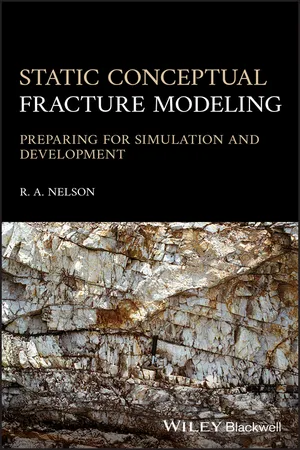
Static Conceptual Fracture Modeling
Preparing for Simulation and Development
- English
- ePUB (mobile friendly)
- Available on iOS & Android
About This Book
Modelling of flow in naturally fractured reservoirs is quickly becoming mandatory in all phases of oil and gas exploration and production. Creation of a Static Conceptual Fracture Model (SCFM) is needed as input to create flow simulations for today and for prediction of flow into the future. Unfortunately, the computer modelers tasked with constructing the gridded fracture model are often not well versed in natural fracture characterization and are often forced to make quick decisions as to the input required by the software used to create these models.
Static Conceptual Fracture Modelling: Preparing for Simulation and Development describes all the fracture and reservoir parameters needed to create the fracture database for effective modelling and how to generate the data and parameter distributions. The material covered in this volume highlights not only natural fracture system quantification and formatting, but also describes best practices for managing technical teams charged with creating the SCFM. This book will become a must on the shelf for all reservoir modelers.
Frequently asked questions
Information
1
Purpose and Scope

2
What Is a Static Conceptual Fracture Model and Why Do We Build It?


Table of contents
- Cover
- Table of Contents
- Foreword
- Acknowledgments
- 1 Purpose and Scope
- 2 What Is a Static Conceptual Fracture Model and Why Do We Build It?
- 3 Fracture Model Creation Workflow
- 4 Gathering Natural Fracture Orientation and Intensity Data Directly
- 5 Gathering Natural Fracture Orientation and Intensity Data Indirectly
- 6 Analyzing the Natural Fracture Data Once Gathered
- 7 Gathering and Analyzing Structural Data
- 8 Gathering Constraints on Fracture Aperture
- 9 Creation of Natural Fracture Scaling Laws
- 10 Gathering and Analyzing Mechanical Property Distribution Data
- 11 Locating Fracture Corridors
- 12 Rock Anisotropy and its Importance in Determining Dominant‐Fracture Orientation and Relative Intensity
- 13 Determine the In‐situ Stress Directions and Magnitudes and their Variation
- 14 Production Calibration
- 15 Determining the Fractured Reservoir Classification and, Therefore, Which Simulation Style Is Most Appropriate
- 16 Use of Reservoir Analogs
- 17 The Importance of 3D Visualization in Data Integration and Static Fracture Model Creation
- 18 Thoughts on History Matching of Simulation Results
- 19 Preparing the Fracture Data for Input to the Gridded Model
- 20 Discussion of Error and Uncertainty in the Modeling Process
- 21 Published Examples of the Process
- 22 Final Comments
- Appendix A: Detailed Static Fracture Modeling Workflow
- Appendix B: How we Use Various Seismic Attributes to Predict Natural Fracture Intensity in the Subsurface, After Nelson (2006)
- Appendix C: How I Learned to Interpret Natural Fractures in Core
- Symbols and Abbreviations
- References
- Index
- End User License Agreement